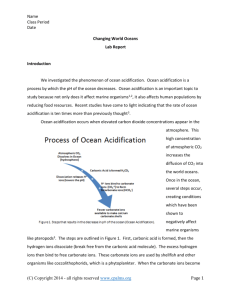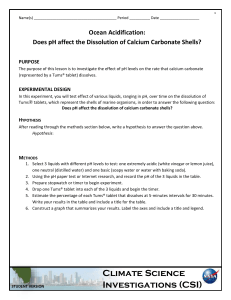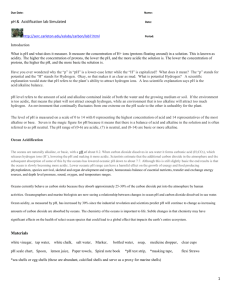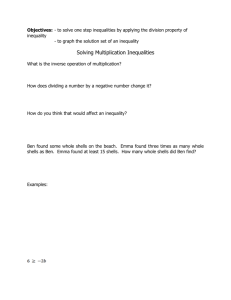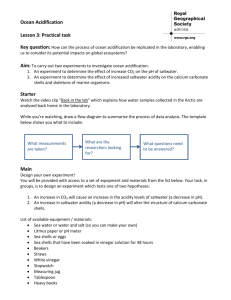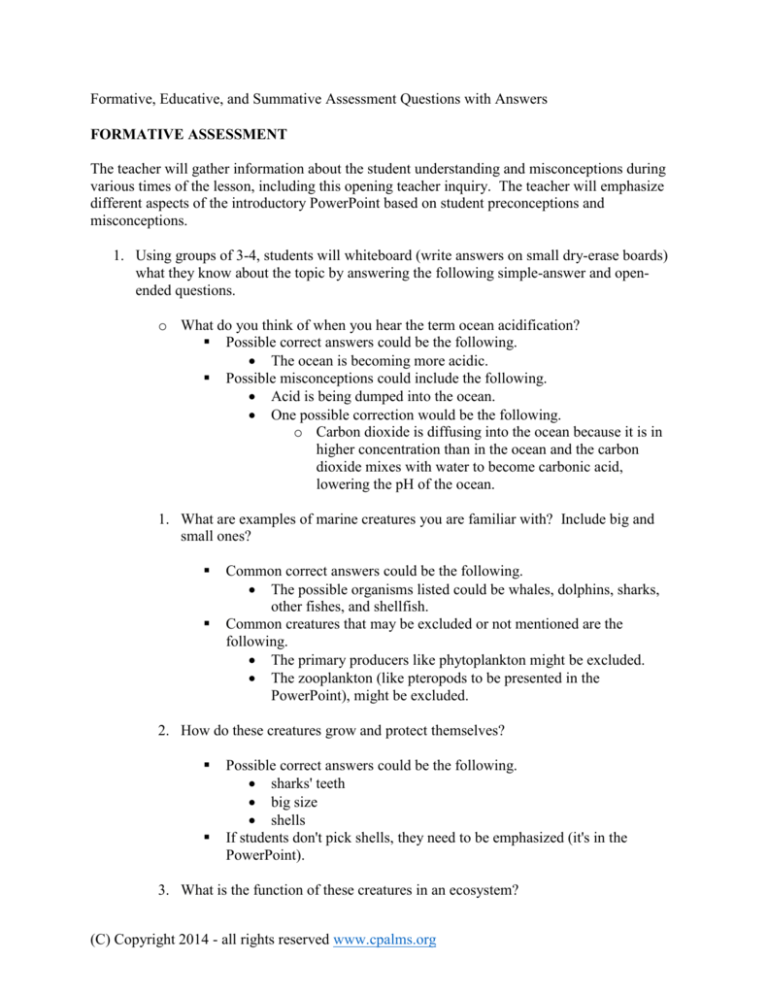
Formative, Educative, and Summative Assessment Questions with Answers
FORMATIVE ASSESSMENT
The teacher will gather information about the student understanding and misconceptions during
various times of the lesson, including this opening teacher inquiry. The teacher will emphasize
different aspects of the introductory PowerPoint based on student preconceptions and
misconceptions.
1. Using groups of 3-4, students will whiteboard (write answers on small dry-erase boards)
what they know about the topic by answering the following simple-answer and openended questions.
o What do you think of when you hear the term ocean acidification?
Possible correct answers could be the following.
The ocean is becoming more acidic.
Possible misconceptions could include the following.
Acid is being dumped into the ocean.
One possible correction would be the following.
o Carbon dioxide is diffusing into the ocean because it is in
higher concentration than in the ocean and the carbon
dioxide mixes with water to become carbonic acid,
lowering the pH of the ocean.
1. What are examples of marine creatures you are familiar with? Include big and
small ones?
Common correct answers could be the following.
The possible organisms listed could be whales, dolphins, sharks,
other fishes, and shellfish.
Common creatures that may be excluded or not mentioned are the
following.
The primary producers like phytoplankton might be excluded.
The zooplankton (like pteropods to be presented in the
PowerPoint), might be excluded.
2. How do these creatures grow and protect themselves?
Possible correct answers could be the following.
sharks' teeth
big size
shells
If students don't pick shells, they need to be emphasized (it's in the
PowerPoint).
3. What is the function of these creatures in an ecosystem?
(C) Copyright 2014 - all rights reserved www.cpalms.org
Depends on the first answers
Larger organisms tend to be higher on the trophic pyramid.
Smaller organisms like phytoplankton are the base of the trophic
pyramid.
Smaller organisms like zooplankton are also low on the trophic
pyramid.
4. How do you think your creatures would be affected by ocean acidification?
Possible correct answers include the following.
Sharks teeth may be eroded.
o We don’t know this at this time.
Shells get eroded.
o This is what will be emphasized in the PowerPoint.
Flesh (proteins) will get eroded.
o This will be demonstrated in the lab activity.
5. What do you think is acidifying the ocean?
Possible misconceptions might include the following.
Adding acid to the ocean from factories might be a misconception.
River runoff may be incorrectly thought of a source of
acidification; it plays a minor localized role.
Possible correct answers could include the following.
Volcanoes do contribute to acidification.
o It comes from the carbon dioxide released.
o It could also come from the sulfur- and nitrogen-oxides, but
most of the acidification comes from the carbon dioxide.
Anthropogenic sources that could contribute to acidification.
o Burning of fossil fuels is probably a more influential
source.
Carbon dioxide is made from the burning of fossil
fuels.
Carbon dioxide is dissolved in the water.
Carbonic acid is formed in the water.
Carbonate ions become more scarce which are
needed by shellfish to make shells.
Shells get weaker.
Potential disruption of food webs can occur.
EDUCATIVE ASSESSMENT
The teacher will circulate among the groups during lab activities (day 2) and ask probing and
guiding questions based on the observations students are making during different phases of the
experimentation including:
(C) Copyright 2014 - all rights reserved www.cpalms.org
1. What are the gas bubbles composed of from the mixing of baking soda and vinegar?
o If the students don't know, ask them what is happening to the carbon dioxide
levels in the atmosphere.
Students should realize it is carbon dioxide being released.
2. What is happening to the carbon dioxide levels?
The concentration of carbon dioxide is increasing.
3. What is happening to the pH levels of the water samples (buffered vs unbuffered)?
Buffered pH may reduce a little but may remain unchanged.
Unbuffered pH will be reducing more than the buffered solution or the solution
with the shells in it.
4. What were your initial observations of the fish muscle tissue?
It is translucent.
It is flexible.
5. What type of solution is vinegar?
It is an acid with a low pH.
6. What type of solution is lemon juice?
It is an acid with a low pH.
7. What do you think the bubbles are that are coming from the shells in vinegar?
The bubbles are carbon dioxide.
8. What do you think will happen to the shells in vinegar?
Shells will lose mass.
Sometimes there might be an initial increase in mass because of absorption of
water by the shell.
9. What do you think will happen to the vinegar with the shells in them?
The vinegar pH will be neutralized resulting in a higher pH.
10. What do you think will happen to the fish muscle tissue in lemon juice?
(C) Copyright 2014 - all rights reserved www.cpalms.org
The protein will denature cooking the fish chemically.
The proteins would no longer function properly.
We use this process to make ceviche (a fish dish).
11. What is being modeled here?
The process that is occurring at the hydrosphere / atmosphere interface.
The high concentration of carbon dioxide is being dissolved into the water
Carbonic acid is formed.
Dissociated hydrogen ions bind with carbonate ions.
Fewer ions are available to make shells.
Organisms with shells are less well adapted for survival and reproduction.
Ecosystems may be severely disrupted if the organisms affected are low in
the food chain.
During Day 3 Reflection, educative feedback will be given by conducting a whiteboard
discussion using probing and guiding questions of the whole process of acidification, eliciting
from the students responses to the following:
1. Describe the effect of the process by which carbon dioxide in the atmosphere dissolves in
the water (hydrosphere), lowering the pH of the water and reducing the concentration of
carbonate ions.
2. Explain the effect of acid on protein and calcium carbonate shells.
3. Explain how acidification of the ocean affects certain marine organisms populations and
ecosystems using empirical data.
Make sure students are recording the explanations and descriptions of the processes. Remind
them that they will use this information to write their lab report.
During Day 4 Lab Report Writing the teacher will provide feedback to students while they write
their different sections.
The teacher should be looking to ensure students are including the appropriate information in
each of the sections.
1. Introduction: make sure students clearly state the following about ocean acidification.
Define ocean acidification.
Explain the importance of studying ocean acidification.
How does it affect specific organisms?
How does it affect ecosystems?
How does it possibly affect humans?
Hypotheses
Write the Scientific Hypothesis.
(C) Copyright 2014 - all rights reserved www.cpalms.org
Write a Statistical Hypothesis.
Examples would be similar to: If acidified oceans negatively affect
marine organisms then those organisms exposed to lower pH levels
will be less well adapted for survival and reproduction.
If calcium carbonate shells are exposed to acid then their mass
would decrease.
If calcium carbonate shells are exposed to acid their physical
structure would change.
If protein like fish filet is exposed to acid, then it will change its
physical appearance becoming more opaque.
If atmospheric carbon dioxide concentration is increased, then the
pH of non buffered water will decrease.
If atmospheric carbon dioxide concentration is increased then the
buffered seawater will decrease.
Write a Null Hypothesis.
If calcium carbonate shells are exposed to acid then their mass
would remain the same.
If calcium carbonate shells are exposed to acid their physical
structure would not change.
If protein like fish filet is exposed to acid, then its appearance will
remain unchanged (remain translucent).
If atmospheric carbon dioxide concentration is increased, then the
pH of non buffered water will remain the same.
If atmospheric carbon dioxide concentration is increased then the
pH of the buffered seawater will remain the same.
2. Materials and Methods: students list all materials used and write a concise procedure that
would allow another student to repeat the experiment.
3. Results: students construct tables, graphs, and statistics and short written descriptions of
each.
4. Discussion: students write how their data support or refute their hypothesis, how the data
compare or help explain other studies, and how the data relate to themselves and society.
SUMMATIVE ASSESSMENT
The summative assessment consists of a comprehensive lab report. This lab report follows
closely how many scientific publications are constructed. When you submit your lab report, also
include your self-graded rubric.
Please use the following format (see the example lab report too):
1. Introduction
1. Tell the audience what the topic is.
(C) Copyright 2014 - all rights reserved www.cpalms.org
1. Introduce the topic.
2. Explain the importance of the topic.
1. How does it relate to the real world or you personally?
1. Support with recent articles that address why you are doing
this project (i.e. how others view the importance of the
topic).
3. Provide an explanation of the process by which ocean acidification occurs.
1. Create a flow chart diagram.
2. In particular, mention the two different spheres involved in the
process.
4. State your hypothesis or hypotheses.
2. Materials and Methods
1. List your materials you used.
1. Ensure the table format is good.
2. Describe the methods you used.
1. Make it brief but detailed enough for another student to be able to
reproduce your experiment.
2. Using bulleted lists work well.
3. Results
1. Include data tables and graphs.
2. Add short paragraphs to describe each of the tables or graphs.
4. Discussion
1. Start with a restatement of the topic and whether your data supported or refuted
your hypothesis.
2. State anything that might have occurred during your lab that might have
influenced your results in an unexpected way.
3. If you think it is important, highlight any outlying data that occurred with
potential explanations as to why it was so different.
4. State how your data represent a model for what is happening in nature.
5. Explain how this lowering of pH in the water will affect the organisms.
1. Mineralized hard parts (shells) might be affected.
2. Soft parts (muscle tissue, protective slime, nervous tissue
(neurotransmitters)) might be affected.
6. Explain how ecosystems can be put out of balance if these organisms are
significantly affected. (Think calcium carbonate shelled phytoplankton as the
example).
7. Make suggestions for future research.
8. Make suggestions to make this lab better.
(C) Copyright 2014 - all rights reserved www.cpalms.org

